University Light Rail System Engineering and Analysis Report
VerifiedAdded on 2020/04/01
|13
|2939
|43
Report
AI Summary
This report provides a comprehensive analysis of the system engineering and analysis of a light rail transit (LRT) framework. It begins with an executive summary and table of contents, followed by an introduction that highlights the importance of LRT in improving transportation efficiency and reducing traffic congestion. The report then delves into the preliminary design, detailing the layout of tracks, overhead electric lines, and the required infrastructure. It emphasizes the importance of a safe and efficient design, including considerations for track integration with other transit systems and the need for noise reduction. The detailed design and development section discusses the project's background, objectives, and methodology, including the use of a system development lifecycle (SDLC) model and project management tools. It also covers cost analysis, work breakdown structure, and resource allocation. Finally, the report addresses system testing, evaluation, validation, and optimization, including the use of system engineering approaches, test successors, and risk analysis. The conclusion summarizes the application of the SDLC model in project development.
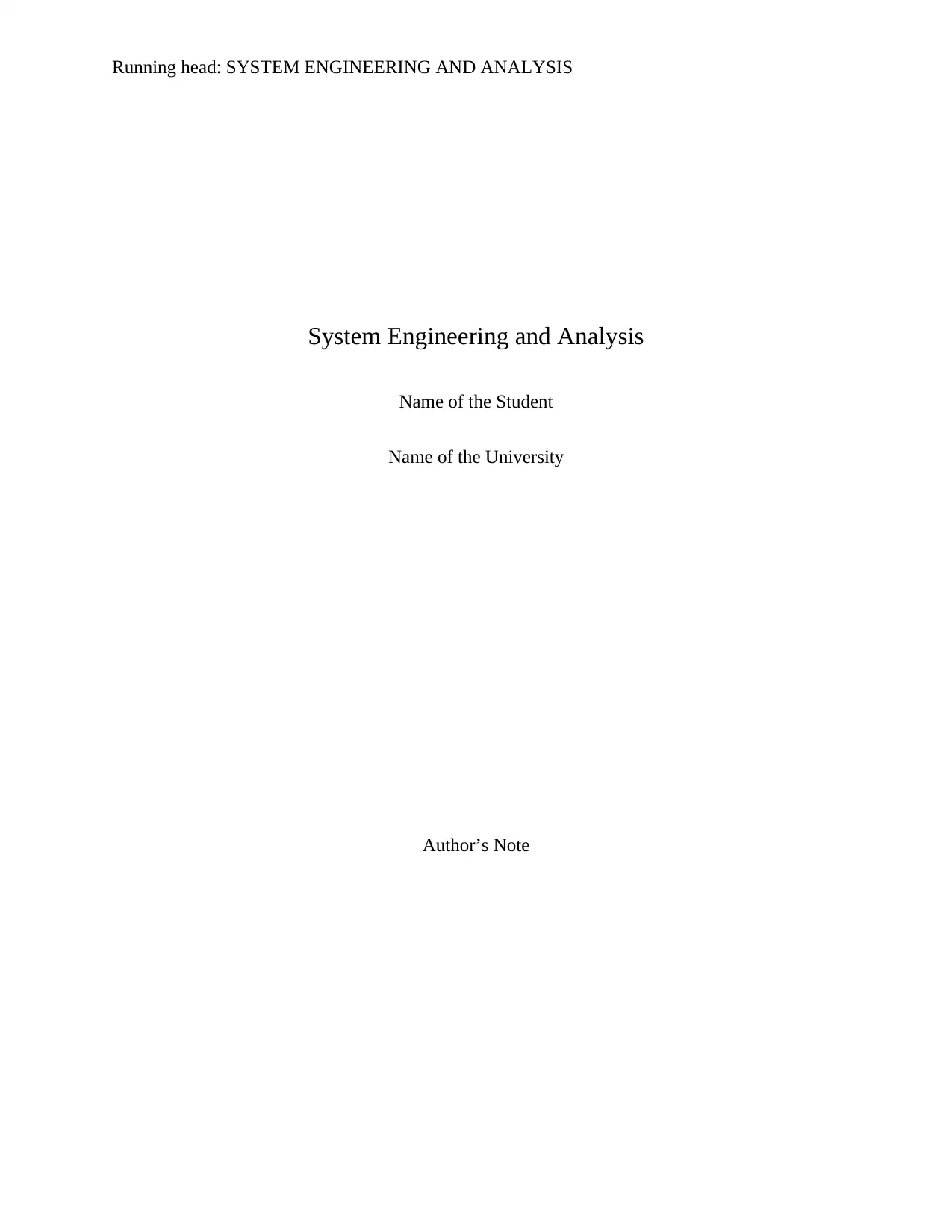
Running head: SYSTEM ENGINEERING AND ANALYSIS
System Engineering and Analysis
Name of the Student
Name of the University
Author’s Note
System Engineering and Analysis
Name of the Student
Name of the University
Author’s Note
Paraphrase This Document
Need a fresh take? Get an instant paraphrase of this document with our AI Paraphraser
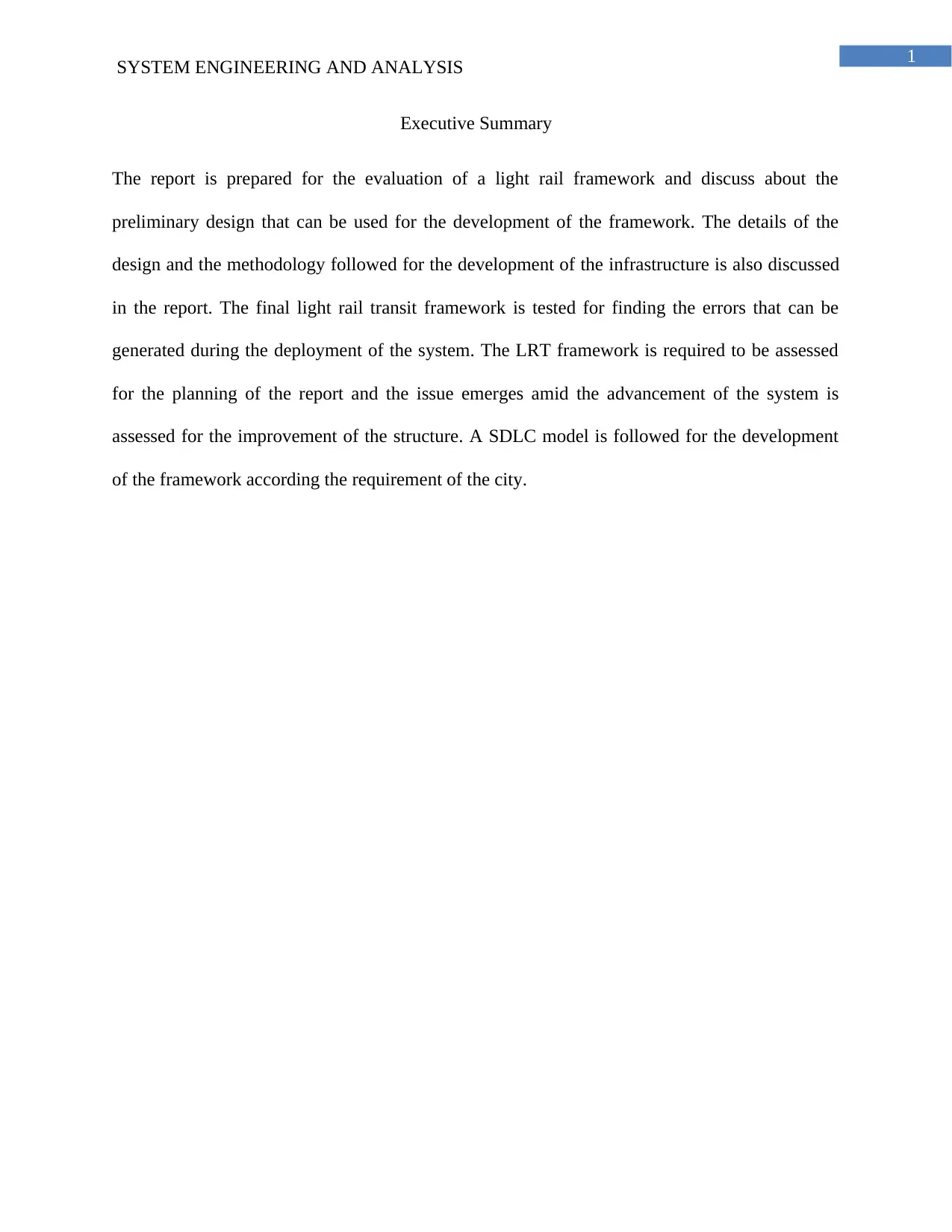
1
SYSTEM ENGINEERING AND ANALYSIS
Executive Summary
The report is prepared for the evaluation of a light rail framework and discuss about the
preliminary design that can be used for the development of the framework. The details of the
design and the methodology followed for the development of the infrastructure is also discussed
in the report. The final light rail transit framework is tested for finding the errors that can be
generated during the deployment of the system. The LRT framework is required to be assessed
for the planning of the report and the issue emerges amid the advancement of the system is
assessed for the improvement of the structure. A SDLC model is followed for the development
of the framework according the requirement of the city.
SYSTEM ENGINEERING AND ANALYSIS
Executive Summary
The report is prepared for the evaluation of a light rail framework and discuss about the
preliminary design that can be used for the development of the framework. The details of the
design and the methodology followed for the development of the infrastructure is also discussed
in the report. The final light rail transit framework is tested for finding the errors that can be
generated during the deployment of the system. The LRT framework is required to be assessed
for the planning of the report and the issue emerges amid the advancement of the system is
assessed for the improvement of the structure. A SDLC model is followed for the development
of the framework according the requirement of the city.
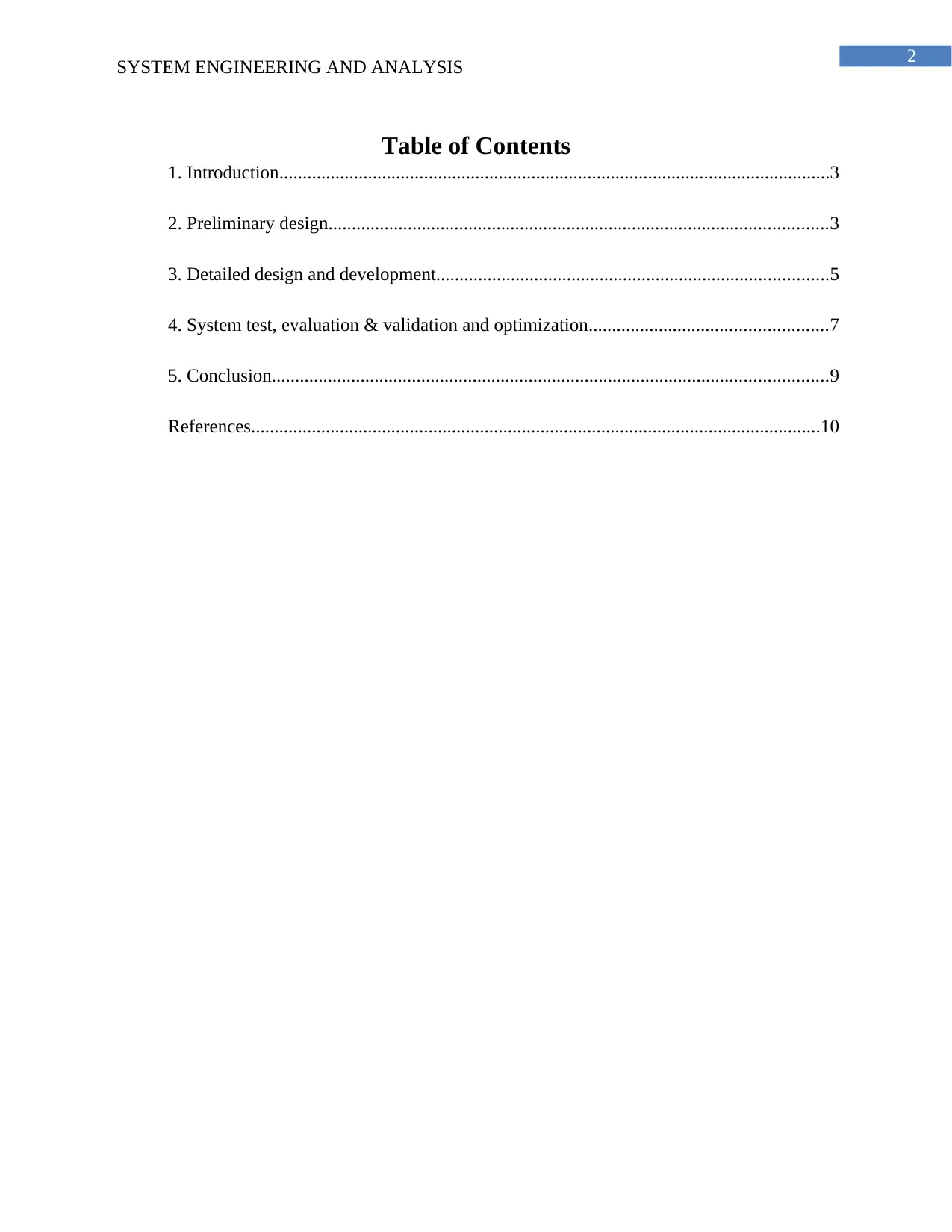
2
SYSTEM ENGINEERING AND ANALYSIS
Table of Contents
1. Introduction......................................................................................................................3
2. Preliminary design...........................................................................................................3
3. Detailed design and development....................................................................................5
4. System test, evaluation & validation and optimization...................................................7
5. Conclusion.......................................................................................................................9
References..........................................................................................................................10
SYSTEM ENGINEERING AND ANALYSIS
Table of Contents
1. Introduction......................................................................................................................3
2. Preliminary design...........................................................................................................3
3. Detailed design and development....................................................................................5
4. System test, evaluation & validation and optimization...................................................7
5. Conclusion.......................................................................................................................9
References..........................................................................................................................10
⊘ This is a preview!⊘
Do you want full access?
Subscribe today to unlock all pages.

Trusted by 1+ million students worldwide
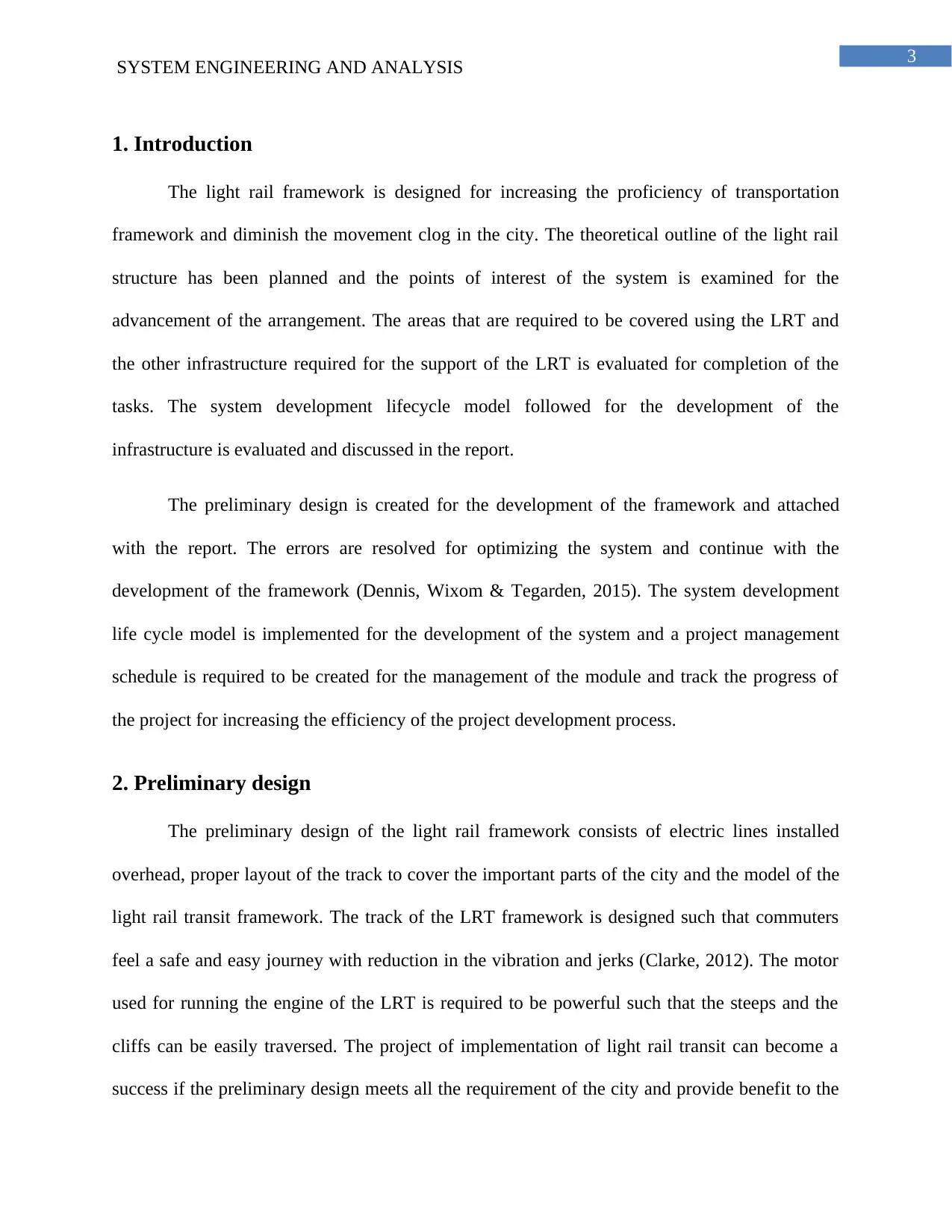
3
SYSTEM ENGINEERING AND ANALYSIS
1. Introduction
The light rail framework is designed for increasing the proficiency of transportation
framework and diminish the movement clog in the city. The theoretical outline of the light rail
structure has been planned and the points of interest of the system is examined for the
advancement of the arrangement. The areas that are required to be covered using the LRT and
the other infrastructure required for the support of the LRT is evaluated for completion of the
tasks. The system development lifecycle model followed for the development of the
infrastructure is evaluated and discussed in the report.
The preliminary design is created for the development of the framework and attached
with the report. The errors are resolved for optimizing the system and continue with the
development of the framework (Dennis, Wixom & Tegarden, 2015). The system development
life cycle model is implemented for the development of the system and a project management
schedule is required to be created for the management of the module and track the progress of
the project for increasing the efficiency of the project development process.
2. Preliminary design
The preliminary design of the light rail framework consists of electric lines installed
overhead, proper layout of the track to cover the important parts of the city and the model of the
light rail transit framework. The track of the LRT framework is designed such that commuters
feel a safe and easy journey with reduction in the vibration and jerks (Clarke, 2012). The motor
used for running the engine of the LRT is required to be powerful such that the steeps and the
cliffs can be easily traversed. The project of implementation of light rail transit can become a
success if the preliminary design meets all the requirement of the city and provide benefit to the
SYSTEM ENGINEERING AND ANALYSIS
1. Introduction
The light rail framework is designed for increasing the proficiency of transportation
framework and diminish the movement clog in the city. The theoretical outline of the light rail
structure has been planned and the points of interest of the system is examined for the
advancement of the arrangement. The areas that are required to be covered using the LRT and
the other infrastructure required for the support of the LRT is evaluated for completion of the
tasks. The system development lifecycle model followed for the development of the
infrastructure is evaluated and discussed in the report.
The preliminary design is created for the development of the framework and attached
with the report. The errors are resolved for optimizing the system and continue with the
development of the framework (Dennis, Wixom & Tegarden, 2015). The system development
life cycle model is implemented for the development of the system and a project management
schedule is required to be created for the management of the module and track the progress of
the project for increasing the efficiency of the project development process.
2. Preliminary design
The preliminary design of the light rail framework consists of electric lines installed
overhead, proper layout of the track to cover the important parts of the city and the model of the
light rail transit framework. The track of the LRT framework is designed such that commuters
feel a safe and easy journey with reduction in the vibration and jerks (Clarke, 2012). The motor
used for running the engine of the LRT is required to be powerful such that the steeps and the
cliffs can be easily traversed. The project of implementation of light rail transit can become a
success if the preliminary design meets all the requirement of the city and provide benefit to the
Paraphrase This Document
Need a fresh take? Get an instant paraphrase of this document with our AI Paraphraser
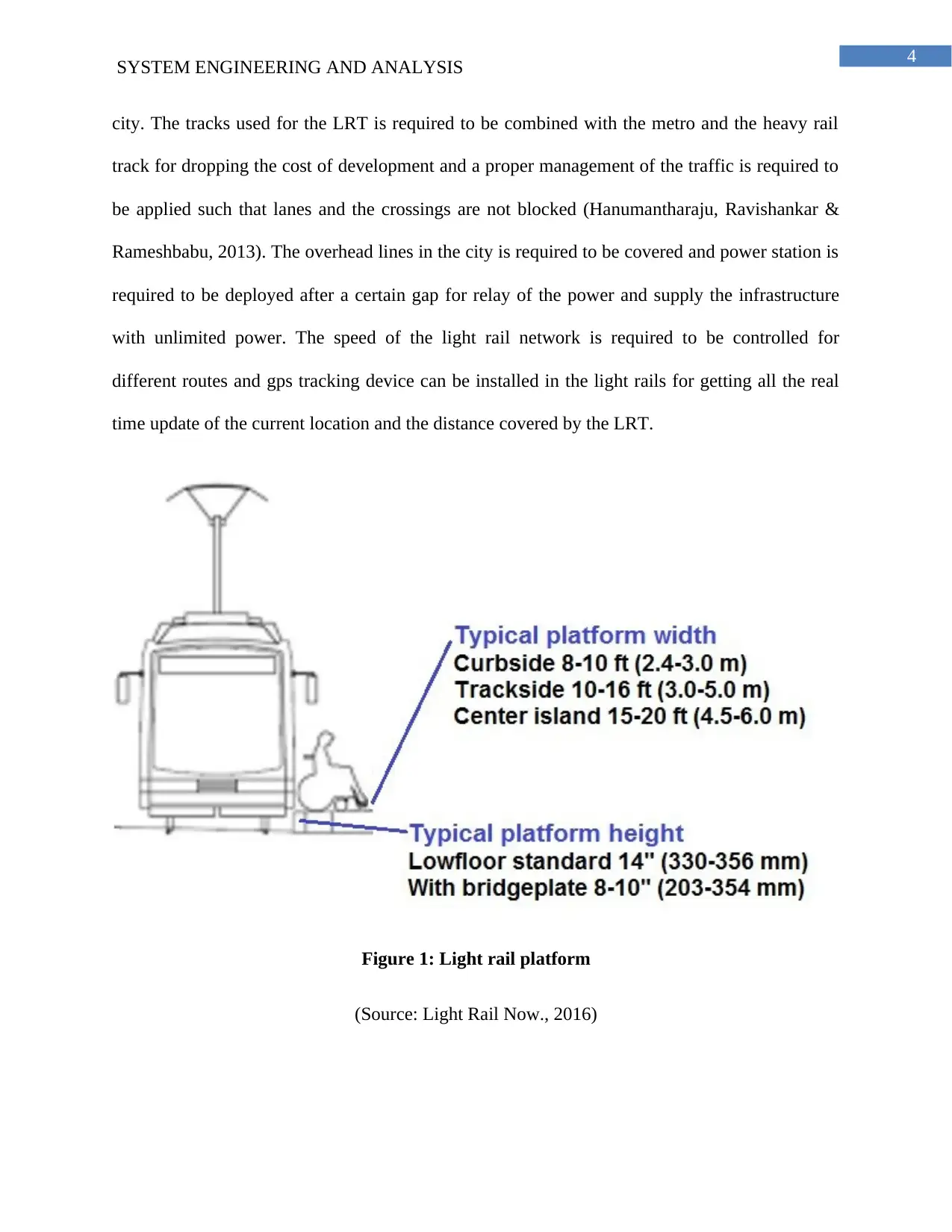
4
SYSTEM ENGINEERING AND ANALYSIS
city. The tracks used for the LRT is required to be combined with the metro and the heavy rail
track for dropping the cost of development and a proper management of the traffic is required to
be applied such that lanes and the crossings are not blocked (Hanumantharaju, Ravishankar &
Rameshbabu, 2013). The overhead lines in the city is required to be covered and power station is
required to be deployed after a certain gap for relay of the power and supply the infrastructure
with unlimited power. The speed of the light rail network is required to be controlled for
different routes and gps tracking device can be installed in the light rails for getting all the real
time update of the current location and the distance covered by the LRT.
Figure 1: Light rail platform
(Source: Light Rail Now., 2016)
SYSTEM ENGINEERING AND ANALYSIS
city. The tracks used for the LRT is required to be combined with the metro and the heavy rail
track for dropping the cost of development and a proper management of the traffic is required to
be applied such that lanes and the crossings are not blocked (Hanumantharaju, Ravishankar &
Rameshbabu, 2013). The overhead lines in the city is required to be covered and power station is
required to be deployed after a certain gap for relay of the power and supply the infrastructure
with unlimited power. The speed of the light rail network is required to be controlled for
different routes and gps tracking device can be installed in the light rails for getting all the real
time update of the current location and the distance covered by the LRT.
Figure 1: Light rail platform
(Source: Light Rail Now., 2016)
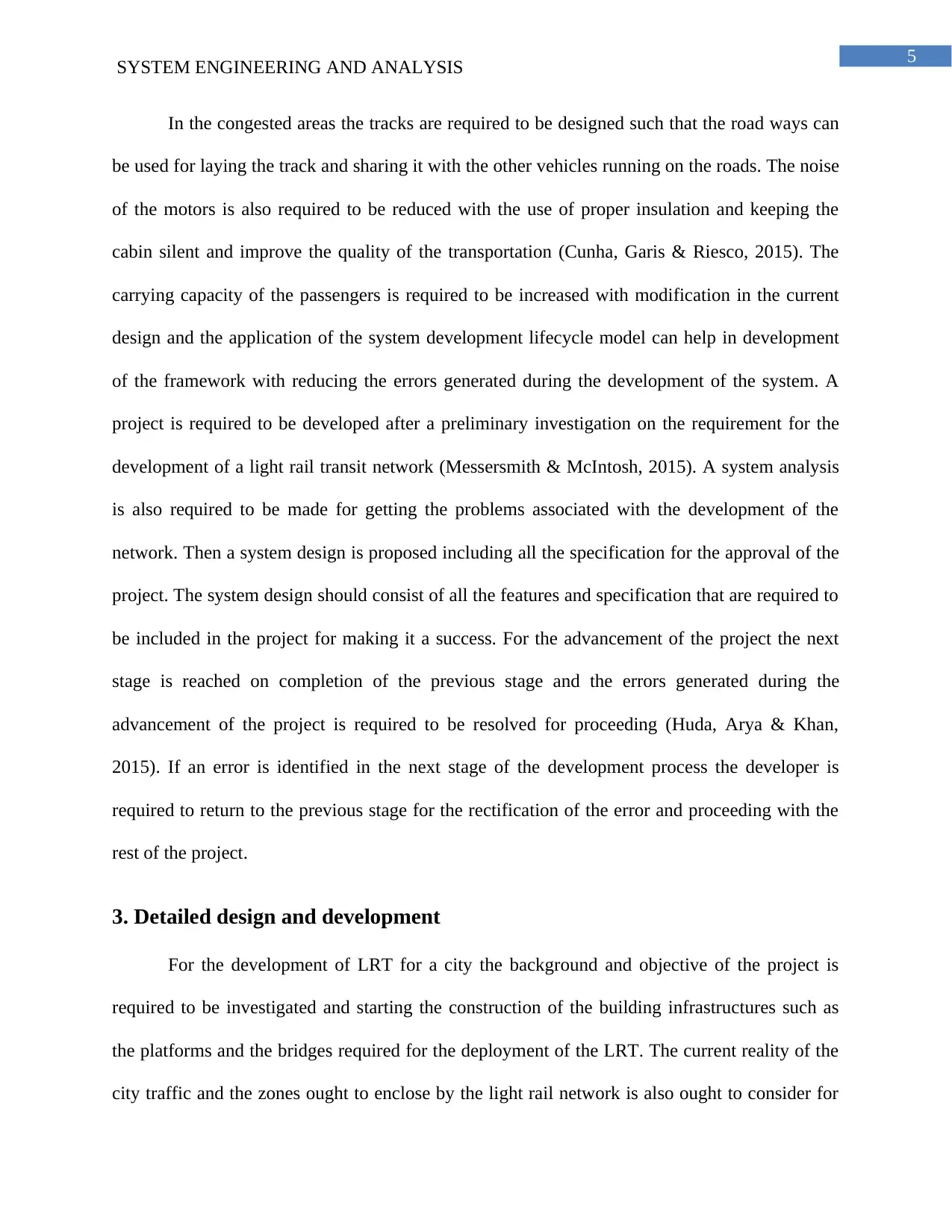
5
SYSTEM ENGINEERING AND ANALYSIS
In the congested areas the tracks are required to be designed such that the road ways can
be used for laying the track and sharing it with the other vehicles running on the roads. The noise
of the motors is also required to be reduced with the use of proper insulation and keeping the
cabin silent and improve the quality of the transportation (Cunha, Garis & Riesco, 2015). The
carrying capacity of the passengers is required to be increased with modification in the current
design and the application of the system development lifecycle model can help in development
of the framework with reducing the errors generated during the development of the system. A
project is required to be developed after a preliminary investigation on the requirement for the
development of a light rail transit network (Messersmith & McIntosh, 2015). A system analysis
is also required to be made for getting the problems associated with the development of the
network. Then a system design is proposed including all the specification for the approval of the
project. The system design should consist of all the features and specification that are required to
be included in the project for making it a success. For the advancement of the project the next
stage is reached on completion of the previous stage and the errors generated during the
advancement of the project is required to be resolved for proceeding (Huda, Arya & Khan,
2015). If an error is identified in the next stage of the development process the developer is
required to return to the previous stage for the rectification of the error and proceeding with the
rest of the project.
3. Detailed design and development
For the development of LRT for a city the background and objective of the project is
required to be investigated and starting the construction of the building infrastructures such as
the platforms and the bridges required for the deployment of the LRT. The current reality of the
city traffic and the zones ought to enclose by the light rail network is also ought to consider for
SYSTEM ENGINEERING AND ANALYSIS
In the congested areas the tracks are required to be designed such that the road ways can
be used for laying the track and sharing it with the other vehicles running on the roads. The noise
of the motors is also required to be reduced with the use of proper insulation and keeping the
cabin silent and improve the quality of the transportation (Cunha, Garis & Riesco, 2015). The
carrying capacity of the passengers is required to be increased with modification in the current
design and the application of the system development lifecycle model can help in development
of the framework with reducing the errors generated during the development of the system. A
project is required to be developed after a preliminary investigation on the requirement for the
development of a light rail transit network (Messersmith & McIntosh, 2015). A system analysis
is also required to be made for getting the problems associated with the development of the
network. Then a system design is proposed including all the specification for the approval of the
project. The system design should consist of all the features and specification that are required to
be included in the project for making it a success. For the advancement of the project the next
stage is reached on completion of the previous stage and the errors generated during the
advancement of the project is required to be resolved for proceeding (Huda, Arya & Khan,
2015). If an error is identified in the next stage of the development process the developer is
required to return to the previous stage for the rectification of the error and proceeding with the
rest of the project.
3. Detailed design and development
For the development of LRT for a city the background and objective of the project is
required to be investigated and starting the construction of the building infrastructures such as
the platforms and the bridges required for the deployment of the LRT. The current reality of the
city traffic and the zones ought to enclose by the light rail network is also ought to consider for
⊘ This is a preview!⊘
Do you want full access?
Subscribe today to unlock all pages.

Trusted by 1+ million students worldwide
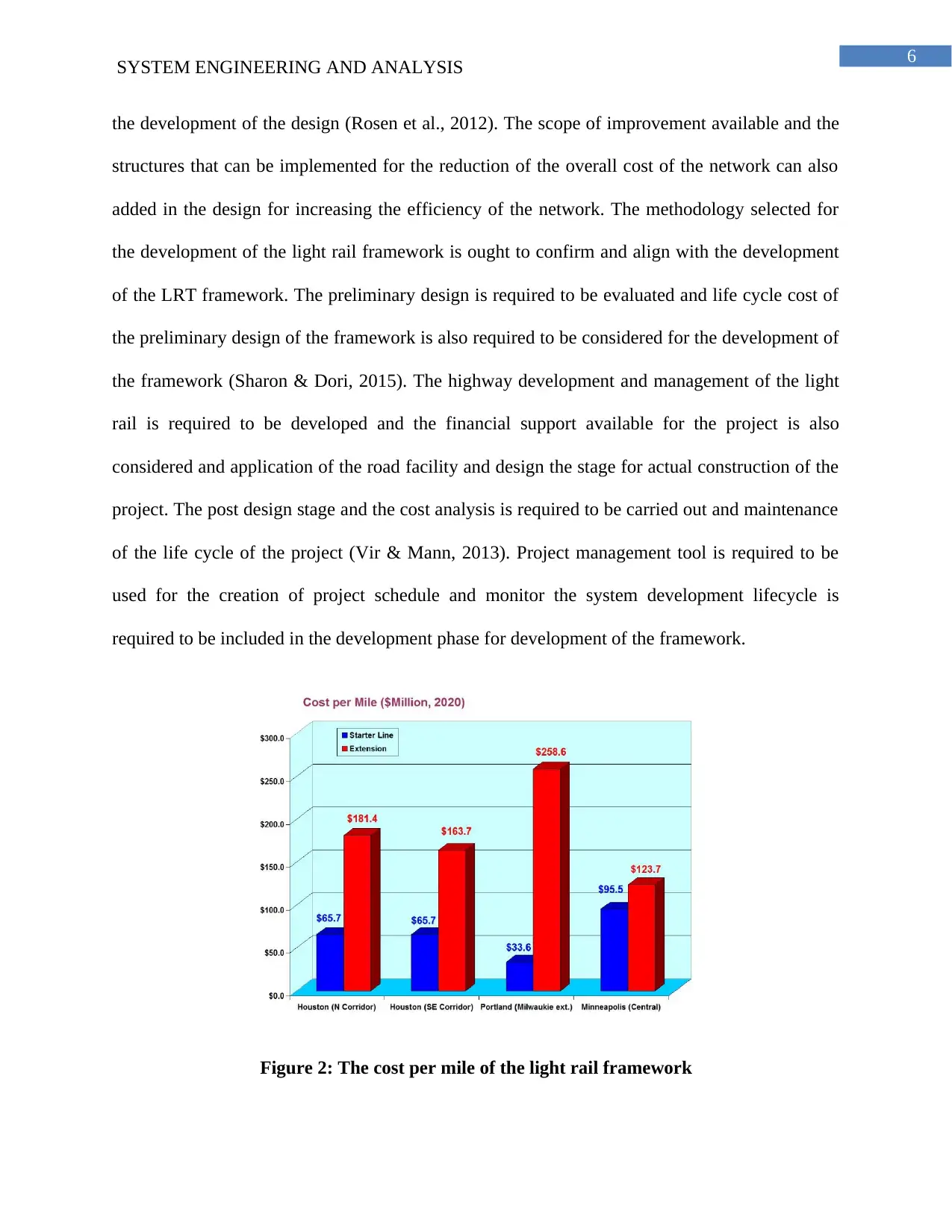
6
SYSTEM ENGINEERING AND ANALYSIS
the development of the design (Rosen et al., 2012). The scope of improvement available and the
structures that can be implemented for the reduction of the overall cost of the network can also
added in the design for increasing the efficiency of the network. The methodology selected for
the development of the light rail framework is ought to confirm and align with the development
of the LRT framework. The preliminary design is required to be evaluated and life cycle cost of
the preliminary design of the framework is also required to be considered for the development of
the framework (Sharon & Dori, 2015). The highway development and management of the light
rail is required to be developed and the financial support available for the project is also
considered and application of the road facility and design the stage for actual construction of the
project. The post design stage and the cost analysis is required to be carried out and maintenance
of the life cycle of the project (Vir & Mann, 2013). Project management tool is required to be
used for the creation of project schedule and monitor the system development lifecycle is
required to be included in the development phase for development of the framework.
Figure 2: The cost per mile of the light rail framework
SYSTEM ENGINEERING AND ANALYSIS
the development of the design (Rosen et al., 2012). The scope of improvement available and the
structures that can be implemented for the reduction of the overall cost of the network can also
added in the design for increasing the efficiency of the network. The methodology selected for
the development of the light rail framework is ought to confirm and align with the development
of the LRT framework. The preliminary design is required to be evaluated and life cycle cost of
the preliminary design of the framework is also required to be considered for the development of
the framework (Sharon & Dori, 2015). The highway development and management of the light
rail is required to be developed and the financial support available for the project is also
considered and application of the road facility and design the stage for actual construction of the
project. The post design stage and the cost analysis is required to be carried out and maintenance
of the life cycle of the project (Vir & Mann, 2013). Project management tool is required to be
used for the creation of project schedule and monitor the system development lifecycle is
required to be included in the development phase for development of the framework.
Figure 2: The cost per mile of the light rail framework
Paraphrase This Document
Need a fresh take? Get an instant paraphrase of this document with our AI Paraphraser
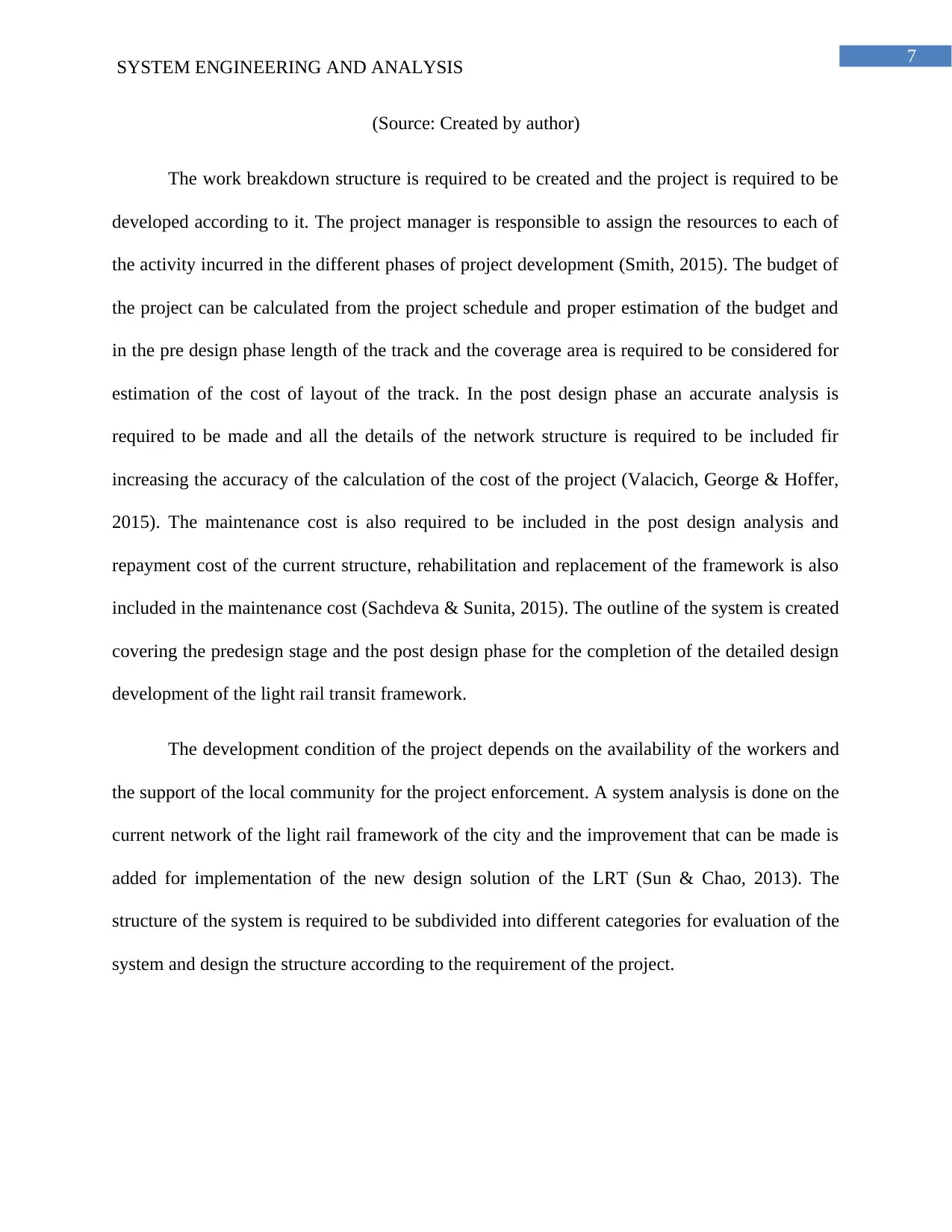
7
SYSTEM ENGINEERING AND ANALYSIS
(Source: Created by author)
The work breakdown structure is required to be created and the project is required to be
developed according to it. The project manager is responsible to assign the resources to each of
the activity incurred in the different phases of project development (Smith, 2015). The budget of
the project can be calculated from the project schedule and proper estimation of the budget and
in the pre design phase length of the track and the coverage area is required to be considered for
estimation of the cost of layout of the track. In the post design phase an accurate analysis is
required to be made and all the details of the network structure is required to be included fir
increasing the accuracy of the calculation of the cost of the project (Valacich, George & Hoffer,
2015). The maintenance cost is also required to be included in the post design analysis and
repayment cost of the current structure, rehabilitation and replacement of the framework is also
included in the maintenance cost (Sachdeva & Sunita, 2015). The outline of the system is created
covering the predesign stage and the post design phase for the completion of the detailed design
development of the light rail transit framework.
The development condition of the project depends on the availability of the workers and
the support of the local community for the project enforcement. A system analysis is done on the
current network of the light rail framework of the city and the improvement that can be made is
added for implementation of the new design solution of the LRT (Sun & Chao, 2013). The
structure of the system is required to be subdivided into different categories for evaluation of the
system and design the structure according to the requirement of the project.
SYSTEM ENGINEERING AND ANALYSIS
(Source: Created by author)
The work breakdown structure is required to be created and the project is required to be
developed according to it. The project manager is responsible to assign the resources to each of
the activity incurred in the different phases of project development (Smith, 2015). The budget of
the project can be calculated from the project schedule and proper estimation of the budget and
in the pre design phase length of the track and the coverage area is required to be considered for
estimation of the cost of layout of the track. In the post design phase an accurate analysis is
required to be made and all the details of the network structure is required to be included fir
increasing the accuracy of the calculation of the cost of the project (Valacich, George & Hoffer,
2015). The maintenance cost is also required to be included in the post design analysis and
repayment cost of the current structure, rehabilitation and replacement of the framework is also
included in the maintenance cost (Sachdeva & Sunita, 2015). The outline of the system is created
covering the predesign stage and the post design phase for the completion of the detailed design
development of the light rail transit framework.
The development condition of the project depends on the availability of the workers and
the support of the local community for the project enforcement. A system analysis is done on the
current network of the light rail framework of the city and the improvement that can be made is
added for implementation of the new design solution of the LRT (Sun & Chao, 2013). The
structure of the system is required to be subdivided into different categories for evaluation of the
system and design the structure according to the requirement of the project.
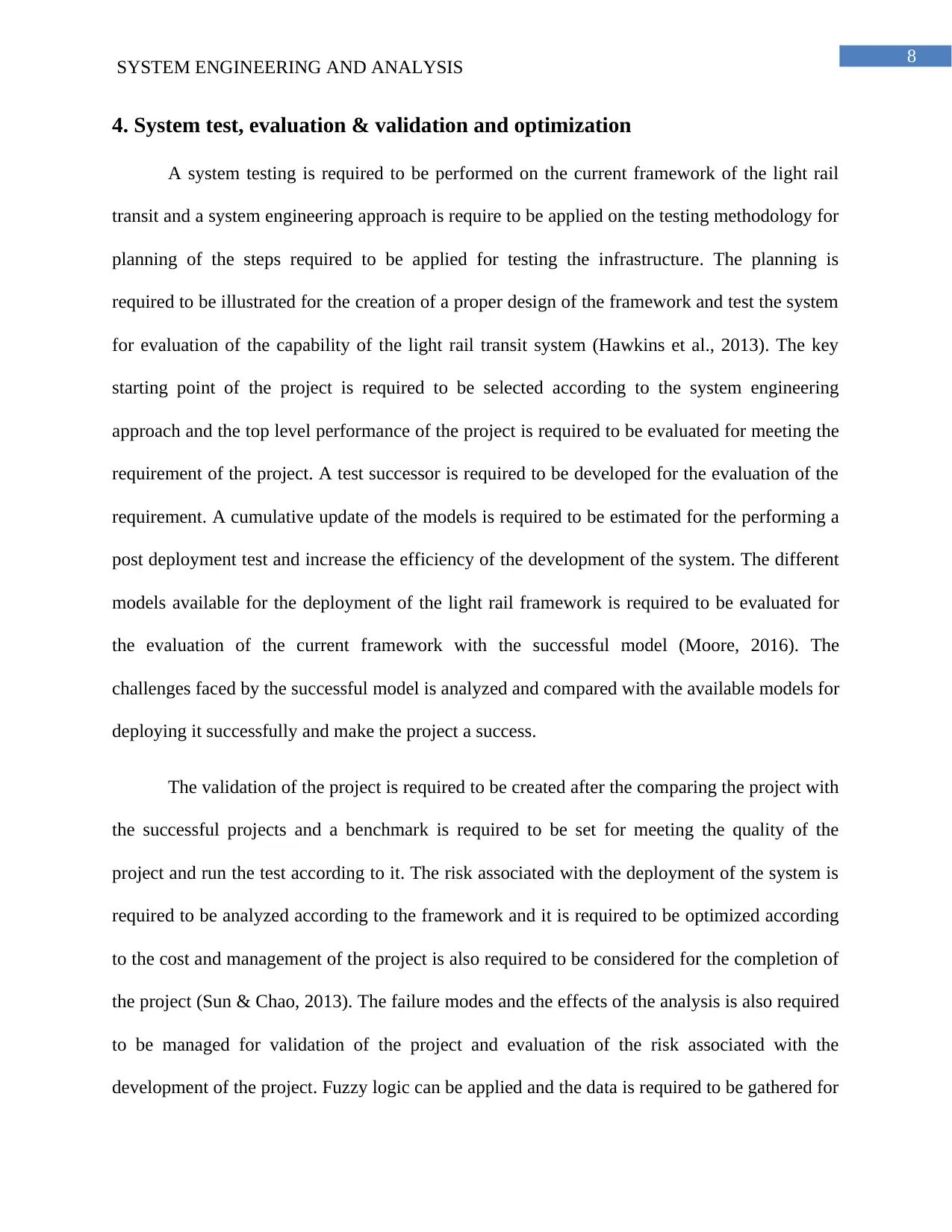
8
SYSTEM ENGINEERING AND ANALYSIS
4. System test, evaluation & validation and optimization
A system testing is required to be performed on the current framework of the light rail
transit and a system engineering approach is require to be applied on the testing methodology for
planning of the steps required to be applied for testing the infrastructure. The planning is
required to be illustrated for the creation of a proper design of the framework and test the system
for evaluation of the capability of the light rail transit system (Hawkins et al., 2013). The key
starting point of the project is required to be selected according to the system engineering
approach and the top level performance of the project is required to be evaluated for meeting the
requirement of the project. A test successor is required to be developed for the evaluation of the
requirement. A cumulative update of the models is required to be estimated for the performing a
post deployment test and increase the efficiency of the development of the system. The different
models available for the deployment of the light rail framework is required to be evaluated for
the evaluation of the current framework with the successful model (Moore, 2016). The
challenges faced by the successful model is analyzed and compared with the available models for
deploying it successfully and make the project a success.
The validation of the project is required to be created after the comparing the project with
the successful projects and a benchmark is required to be set for meeting the quality of the
project and run the test according to it. The risk associated with the deployment of the system is
required to be analyzed according to the framework and it is required to be optimized according
to the cost and management of the project is also required to be considered for the completion of
the project (Sun & Chao, 2013). The failure modes and the effects of the analysis is also required
to be managed for validation of the project and evaluation of the risk associated with the
development of the project. Fuzzy logic can be applied and the data is required to be gathered for
SYSTEM ENGINEERING AND ANALYSIS
4. System test, evaluation & validation and optimization
A system testing is required to be performed on the current framework of the light rail
transit and a system engineering approach is require to be applied on the testing methodology for
planning of the steps required to be applied for testing the infrastructure. The planning is
required to be illustrated for the creation of a proper design of the framework and test the system
for evaluation of the capability of the light rail transit system (Hawkins et al., 2013). The key
starting point of the project is required to be selected according to the system engineering
approach and the top level performance of the project is required to be evaluated for meeting the
requirement of the project. A test successor is required to be developed for the evaluation of the
requirement. A cumulative update of the models is required to be estimated for the performing a
post deployment test and increase the efficiency of the development of the system. The different
models available for the deployment of the light rail framework is required to be evaluated for
the evaluation of the current framework with the successful model (Moore, 2016). The
challenges faced by the successful model is analyzed and compared with the available models for
deploying it successfully and make the project a success.
The validation of the project is required to be created after the comparing the project with
the successful projects and a benchmark is required to be set for meeting the quality of the
project and run the test according to it. The risk associated with the deployment of the system is
required to be analyzed according to the framework and it is required to be optimized according
to the cost and management of the project is also required to be considered for the completion of
the project (Sun & Chao, 2013). The failure modes and the effects of the analysis is also required
to be managed for validation of the project and evaluation of the risk associated with the
development of the project. Fuzzy logic can be applied and the data is required to be gathered for
⊘ This is a preview!⊘
Do you want full access?
Subscribe today to unlock all pages.

Trusted by 1+ million students worldwide
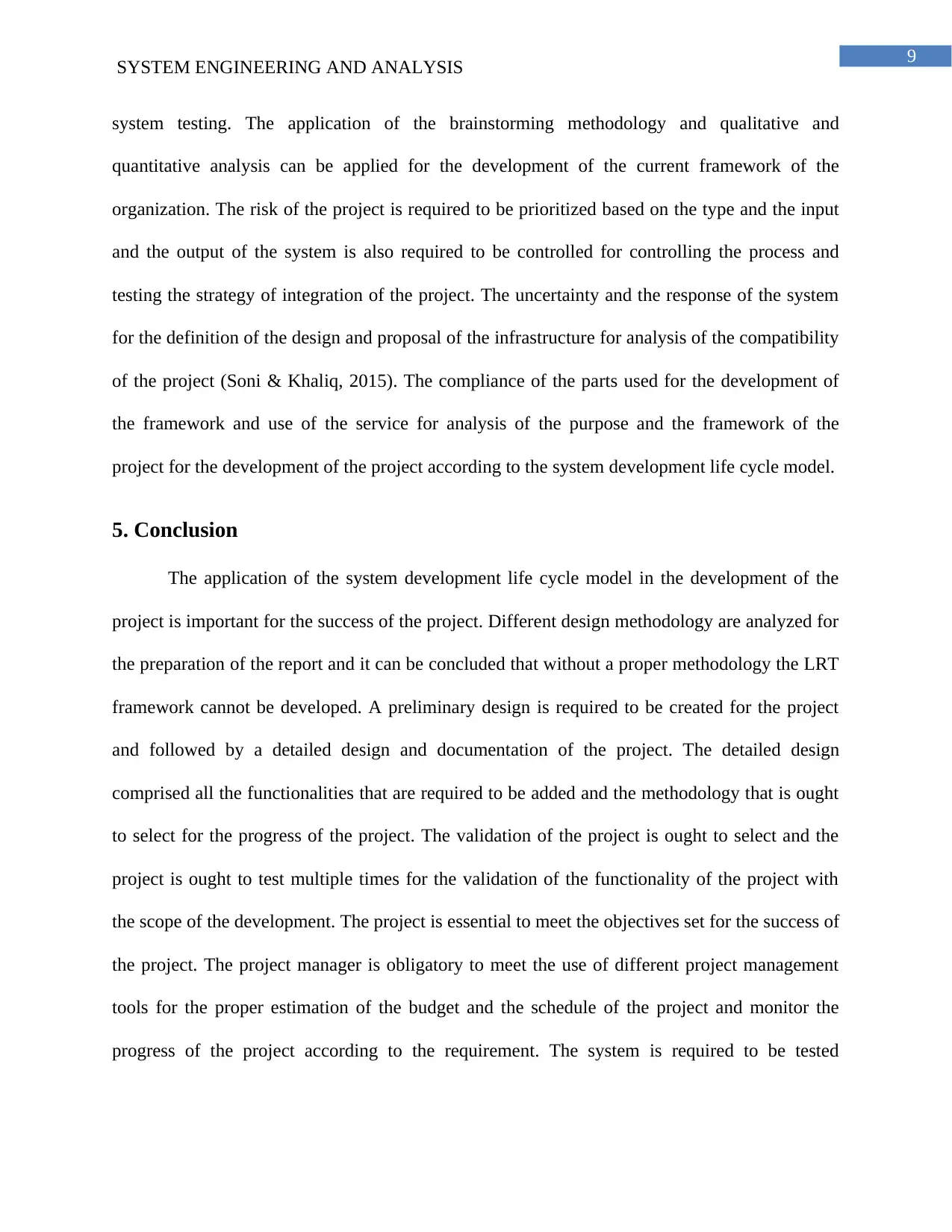
9
SYSTEM ENGINEERING AND ANALYSIS
system testing. The application of the brainstorming methodology and qualitative and
quantitative analysis can be applied for the development of the current framework of the
organization. The risk of the project is required to be prioritized based on the type and the input
and the output of the system is also required to be controlled for controlling the process and
testing the strategy of integration of the project. The uncertainty and the response of the system
for the definition of the design and proposal of the infrastructure for analysis of the compatibility
of the project (Soni & Khaliq, 2015). The compliance of the parts used for the development of
the framework and use of the service for analysis of the purpose and the framework of the
project for the development of the project according to the system development life cycle model.
5. Conclusion
The application of the system development life cycle model in the development of the
project is important for the success of the project. Different design methodology are analyzed for
the preparation of the report and it can be concluded that without a proper methodology the LRT
framework cannot be developed. A preliminary design is required to be created for the project
and followed by a detailed design and documentation of the project. The detailed design
comprised all the functionalities that are required to be added and the methodology that is ought
to select for the progress of the project. The validation of the project is ought to select and the
project is ought to test multiple times for the validation of the functionality of the project with
the scope of the development. The project is essential to meet the objectives set for the success of
the project. The project manager is obligatory to meet the use of different project management
tools for the proper estimation of the budget and the schedule of the project and monitor the
progress of the project according to the requirement. The system is required to be tested
SYSTEM ENGINEERING AND ANALYSIS
system testing. The application of the brainstorming methodology and qualitative and
quantitative analysis can be applied for the development of the current framework of the
organization. The risk of the project is required to be prioritized based on the type and the input
and the output of the system is also required to be controlled for controlling the process and
testing the strategy of integration of the project. The uncertainty and the response of the system
for the definition of the design and proposal of the infrastructure for analysis of the compatibility
of the project (Soni & Khaliq, 2015). The compliance of the parts used for the development of
the framework and use of the service for analysis of the purpose and the framework of the
project for the development of the project according to the system development life cycle model.
5. Conclusion
The application of the system development life cycle model in the development of the
project is important for the success of the project. Different design methodology are analyzed for
the preparation of the report and it can be concluded that without a proper methodology the LRT
framework cannot be developed. A preliminary design is required to be created for the project
and followed by a detailed design and documentation of the project. The detailed design
comprised all the functionalities that are required to be added and the methodology that is ought
to select for the progress of the project. The validation of the project is ought to select and the
project is ought to test multiple times for the validation of the functionality of the project with
the scope of the development. The project is essential to meet the objectives set for the success of
the project. The project manager is obligatory to meet the use of different project management
tools for the proper estimation of the budget and the schedule of the project and monitor the
progress of the project according to the requirement. The system is required to be tested
Paraphrase This Document
Need a fresh take? Get an instant paraphrase of this document with our AI Paraphraser

10
SYSTEM ENGINEERING AND ANALYSIS
according to the created schedule and the budget of the project is also required to be evaluated
for the development of the project.
SYSTEM ENGINEERING AND ANALYSIS
according to the created schedule and the budget of the project is also required to be evaluated
for the development of the project.
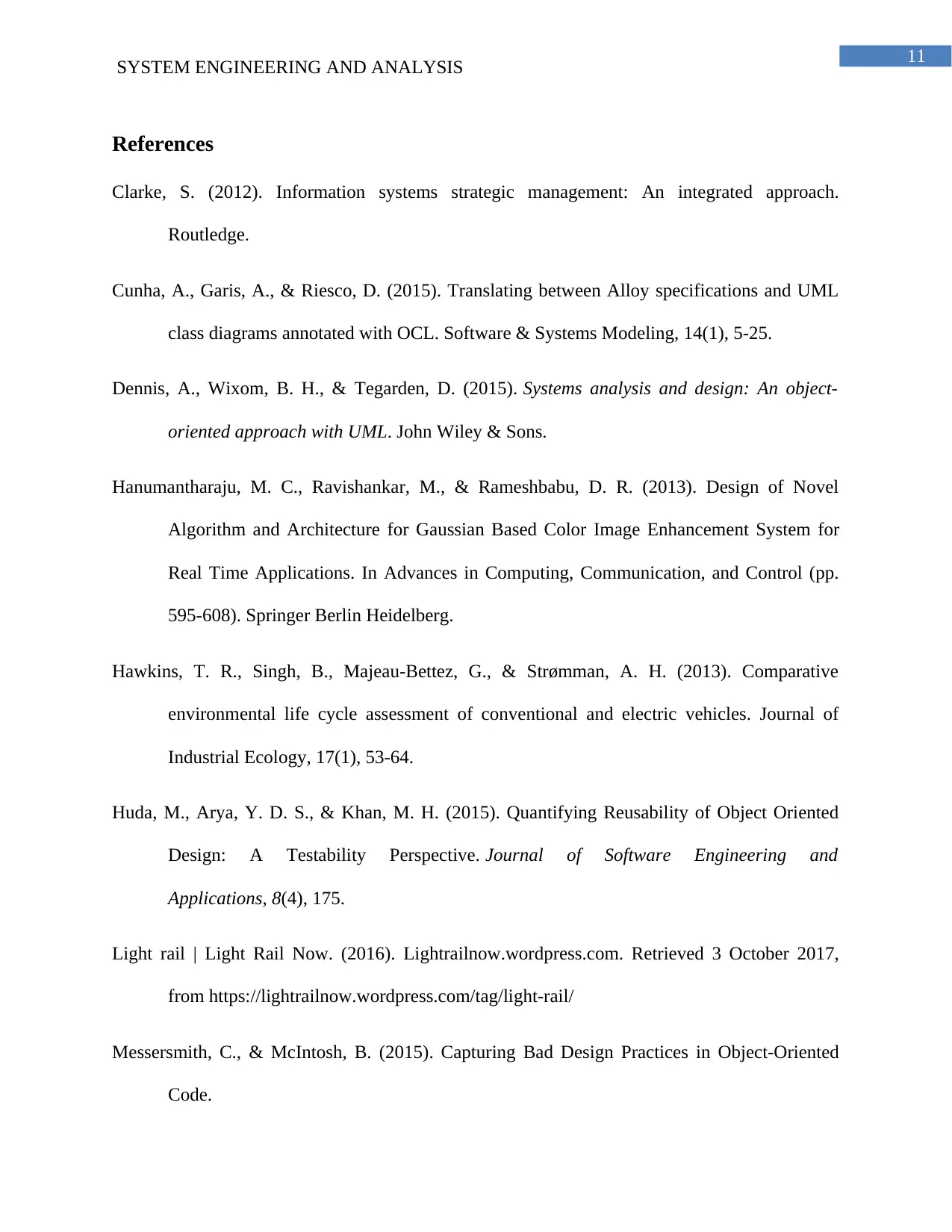
11
SYSTEM ENGINEERING AND ANALYSIS
References
Clarke, S. (2012). Information systems strategic management: An integrated approach.
Routledge.
Cunha, A., Garis, A., & Riesco, D. (2015). Translating between Alloy specifications and UML
class diagrams annotated with OCL. Software & Systems Modeling, 14(1), 5-25.
Dennis, A., Wixom, B. H., & Tegarden, D. (2015). Systems analysis and design: An object-
oriented approach with UML. John Wiley & Sons.
Hanumantharaju, M. C., Ravishankar, M., & Rameshbabu, D. R. (2013). Design of Novel
Algorithm and Architecture for Gaussian Based Color Image Enhancement System for
Real Time Applications. In Advances in Computing, Communication, and Control (pp.
595-608). Springer Berlin Heidelberg.
Hawkins, T. R., Singh, B., Majeau‐Bettez, G., & Strømman, A. H. (2013). Comparative
environmental life cycle assessment of conventional and electric vehicles. Journal of
Industrial Ecology, 17(1), 53-64.
Huda, M., Arya, Y. D. S., & Khan, M. H. (2015). Quantifying Reusability of Object Oriented
Design: A Testability Perspective. Journal of Software Engineering and
Applications, 8(4), 175.
Light rail | Light Rail Now. (2016). Lightrailnow.wordpress.com. Retrieved 3 October 2017,
from https://lightrailnow.wordpress.com/tag/light-rail/
Messersmith, C., & McIntosh, B. (2015). Capturing Bad Design Practices in Object-Oriented
Code.
SYSTEM ENGINEERING AND ANALYSIS
References
Clarke, S. (2012). Information systems strategic management: An integrated approach.
Routledge.
Cunha, A., Garis, A., & Riesco, D. (2015). Translating between Alloy specifications and UML
class diagrams annotated with OCL. Software & Systems Modeling, 14(1), 5-25.
Dennis, A., Wixom, B. H., & Tegarden, D. (2015). Systems analysis and design: An object-
oriented approach with UML. John Wiley & Sons.
Hanumantharaju, M. C., Ravishankar, M., & Rameshbabu, D. R. (2013). Design of Novel
Algorithm and Architecture for Gaussian Based Color Image Enhancement System for
Real Time Applications. In Advances in Computing, Communication, and Control (pp.
595-608). Springer Berlin Heidelberg.
Hawkins, T. R., Singh, B., Majeau‐Bettez, G., & Strømman, A. H. (2013). Comparative
environmental life cycle assessment of conventional and electric vehicles. Journal of
Industrial Ecology, 17(1), 53-64.
Huda, M., Arya, Y. D. S., & Khan, M. H. (2015). Quantifying Reusability of Object Oriented
Design: A Testability Perspective. Journal of Software Engineering and
Applications, 8(4), 175.
Light rail | Light Rail Now. (2016). Lightrailnow.wordpress.com. Retrieved 3 October 2017,
from https://lightrailnow.wordpress.com/tag/light-rail/
Messersmith, C., & McIntosh, B. (2015). Capturing Bad Design Practices in Object-Oriented
Code.
⊘ This is a preview!⊘
Do you want full access?
Subscribe today to unlock all pages.

Trusted by 1+ million students worldwide
1 out of 13
Related Documents
Your All-in-One AI-Powered Toolkit for Academic Success.
+13062052269
info@desklib.com
Available 24*7 on WhatsApp / Email
![[object Object]](/_next/static/media/star-bottom.7253800d.svg)
Unlock your academic potential
Copyright © 2020–2025 A2Z Services. All Rights Reserved. Developed and managed by ZUCOL.





